Bigfoot’s Killer-N 1102 Wireless Networking vs. the World
by Jarred Walton on August 10, 2011 10:38 AM ESTCisco/Linksys E4200 Dual-Band Obstructed Performance
Moving to our obstructed testing with the router at the other end of the house, we shifted locations. (If you must know, my wife wasn’t particularly pleased about the mess in our upstairs bedroom. Sorry!) This test location is actually very useful for me as the router is located in my office while I’m testing the laptops in my living room—right next to my HTPC. While the Linksys E4200 appears to do a lot better than the Netgear in our obstructed tests, we’re no longer testing on different floors and the results aren’t directly comparable (though the laptops are still about 40 feet from the router with a couple walls in between). We hope to do additional wireless testing in the near future (assuming there’s a demand for it) where we will try to provide a better view of performance using the same antennae, but for now let’s see how the cards do with an obstructed signal and the potential to use a 5GHz radio.
Connection rates are interesting to discuss as well. Realtek drops to 58Mbps, again about half of what it seemed to get with the Netgear router. The Intel 1030 maintains a relatively consistent 144Mbps connection. The ASUS K53E with a 6230 chip ranges from around 78 to 180Mbps, the Clevo Intel 6230 laptop maintains a relatively consistent 130-144Mbps, and the Intel 6300 connection speed ranges from around 130 to 180Mbps. As mentioned earlier, the Atheros and Bigfoot drivers apparently don’t pass real-time network data rate information along to Windows, so both were steady—the Atheros shows 130Mbps and the Bigfoot shows a constant 300Mbps, though it’s clear from the results that they’re dropping to lower data rates because of interference.
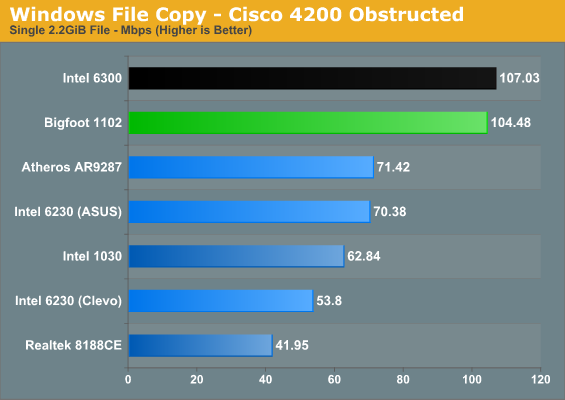
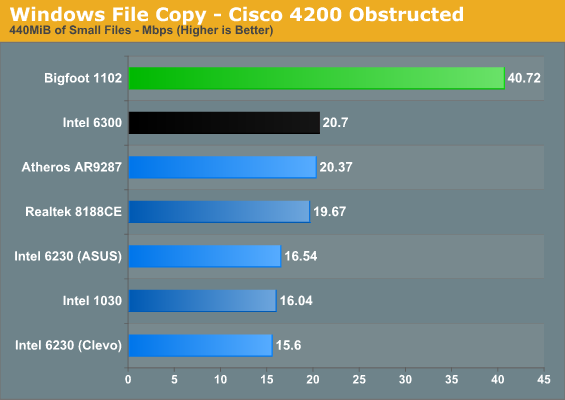
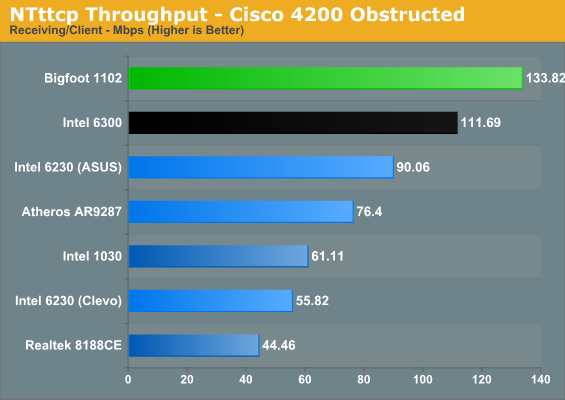
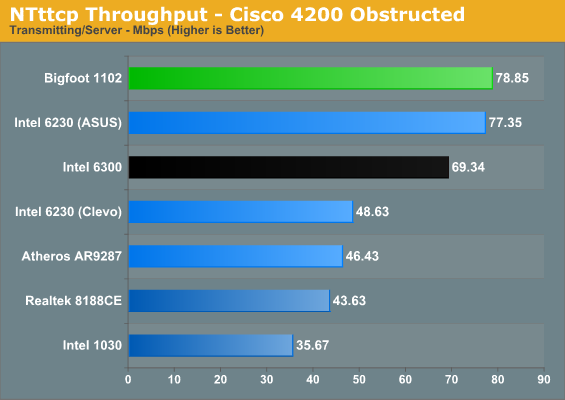
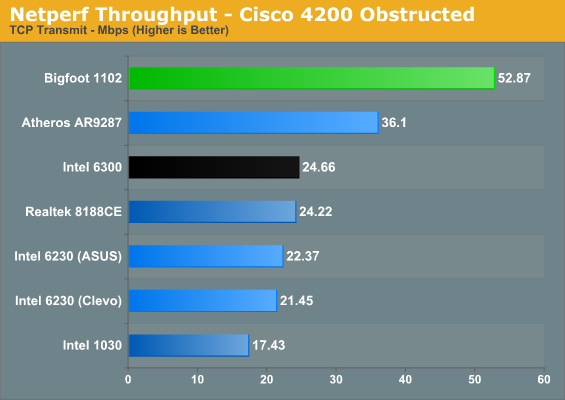
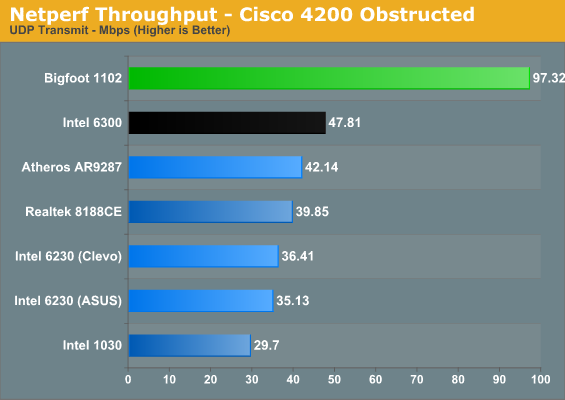
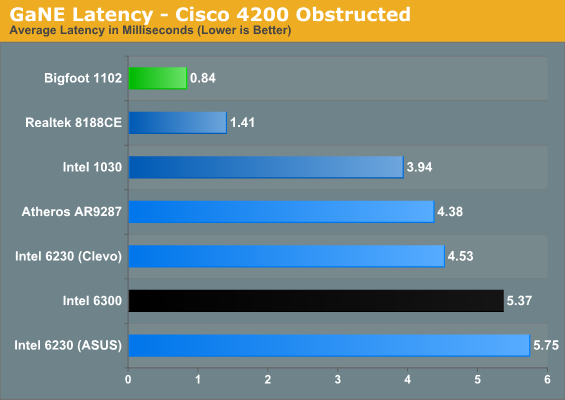
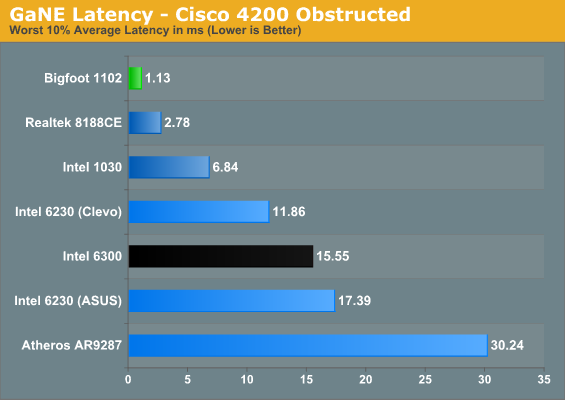
While the Bigfoot 1102 victory wasn’t quite as clear in our ideal test scenario with the Linksys router, its obstructed performance is once again at the top of the charts. The only test where it drops to second is against the Intel 6300 for the large file copy. Balance that against NTttcp performance that’s around 20% higher than the 6300 and Netperf results that are more than double that of the closest competitor. Latency is also much lower than the competition, and the only card that comes close—Realtek’s 8188CE—only had a single spatial stream to contend with. Copying lots of smaller files gives Bigfoot another major victory, with throughput almost double that of the 6300.
With a less than ideal signal location, the lack of 5GHz support doesn’t hurt the Atheros card as much. It typically comes in ahead of both 6230 laptops and takes about half of the categories against the Intel 6300. However, even though the results look decent, in the real world you’re much better off with a chipset that can support 5GHz radios. Go to any convention and you’ll find the 2.4GHz spectrum is completely saturated; you need to find a 5GHz hotspot if you’re going to have a chance at getting your signal through (at least until everyone else starts using 5GHz radios as well). That brings us to our next topic: signal range.










52 Comments
View All Comments
Aikouka - Wednesday, August 10, 2011 - link
Jarred, if you asked me about a year ago... I never thought I'd recommend a Netgear product. My past encounters with their networking devices has been less than stellar. Even with that, I decided to take the plunge, and I purchased a WNDR3700 a few months back. It has treated me rather well so far and that's on stock firmware. It is DD-WRT compatible; so if you prefer their firmware, you're good to flash.Compared to the Airport Extreme, it is a bit weaker on the wireless front as it only supports MIMO 2x2, but its newer sibling, the WNDR4000, supports MIMO 3x3.
The one feature I'd definitely argue for though is simultaneous dual-band. I don't think most people have homes with only 5Ghz devices. So with just a dual-band router, you'd be limited to 2.4Ghz anyway.
xand42 - Wednesday, August 10, 2011 - link
Any idea why the (default parameter) netperf tcp transmit results are so horrible across the board? I just ran netperf on my Advanced-N 6200 notebook and got 190Mbit/s to my Cisco E3000 router, basically the same value as with iperf and netcat and every other benchmark.Rick83 - Wednesday, August 10, 2011 - link
It would be fairly interesting to see the difference between the Killer NIC, server NICs, laptop NICs and desktop NIC's from different vendors (and in different implementations).As I run only a SSD in my desktop, and have my user profile residing on a NAS (Intel i5 powered NAS, though, not limited by the available cycles and RAM) on a RAID 5, with reasonable linear throughput, network performance is quite important for me, as it accelerates such tasks as generating thumbnails of files, listing large directories, local decompression (that's probably the worst offender, and with large archives I do this on the NAS directly) and many tasks that access my user profile that may be latency or throughput limited.
For this reason I recently specifically got a mainboard with Intel network adapter, hoping for enhanced performance, but only realizing, that I'd have to hack the .inf to get driver support under my OS.
On the NAS, I am currently using the RTL 8111D chips, one connected to the switch and the other to the modem. If using a decent chip increases my samba/nfs performance, I'd put down the 50 euros for the intel pro chip in a blink.
Also you could test supported cable length, jumbo frame support, documentation (with some cards the maximum MTU is not properly documented, and it takes ages of non-fragmented pinging to discover the correct MTU) and performance of teaming and fail-over mechanisms.
Also, 5Ghz was something that I tried in my parent's home, but we couldn't even connect a machine that was one ceiling and wall away, at less than 10 meters distance. Might have been just a spectacularly bad router (Linksys 320N) or maybe 5GHz is really just for line-of-sight applications.
pityme - Wednesday, August 10, 2011 - link
Jarred,I think it would be nice to run tests of multiple wireless network interference like the kind observed in apartment/townhouse/condo situations. This is a big problem that no one seems to ever test/talk about.
ckryan - Wednesday, August 10, 2011 - link
True that. I live in a condo building in uptown Charlotte, NC and every unit has a wireless router of one kind or another. To make matters worse, the elevators seem to interfere somehow -- along with every wireless phone and microwave, the acres of glass and the steel structure. To top it off, there's an office building right next door which has many wireless systems on its own.ckryan - Wednesday, August 10, 2011 - link
Sometimes it seems like someone has cast some manner of evil voodoo on WiFi as a whole.I bought a Killer 2100 NIC because I thought it was a good idea -- and it was on sale. It is better than Intel's on-board Ethernet (and better still than Realtek) if only just barely. In reality, I just liked the idea of dedicated hardware for my networking needs. It really did make a difference, and really is some good stuff, but probably not worth the substantial premium over garden variety PCIe NICs (for most people). I'm glad I bought it... but only because it was on sale.
The Killer product line is in the position of having a product family which does perform mostly as advertised, but becomes a tough sell when you already have onboard ethernet or wifi. It has to be difficult to sell a consumer NIC that costs as much as a 80GB SSD or mid range video card. For $65 or $70 it's great. At $140, not so much. As such, I'm glad to see them trying to put their hardware inside other hardware, like networking cordon bleu. Shoving their "NPU" onto the PCBs of video and sound cards, motherboards, and laptops is a good idea and if nothing else add a little variety to the mix. It would easily be worth an extra $25 -$35 premium for a motherboard in any price range to get their NIC over the bog standard Realtek. It can't possibly cost more than the NF200 or Hydra chips on mid and high end mainboards and is surely worth an extra $20 on top of a laptop as well. Whether they can sell this particular device sans lappy at a reasonable price or even at all remains to be seen.
honvl - Wednesday, August 10, 2011 - link
I'm on a wireless card and want to test my latency. Where can I find this GaNE tool?Flunk - Wednesday, August 10, 2011 - link
This result really surprised me, I was expecting results like their wired products (no difference). My guess is that the biggest factor is the support for more channels but the performance really does seem markably better. I'm gearing up to by a new Alienware laptop near the end of the year and I may very well check the box for a Killer-N upgrade.StormyParis - Wednesday, August 10, 2011 - link
Isn't there a wide gap between what tech sites review, and what users use ? I know it's part of the purview of a tech site to go for the 0.001%-of-users, bleeding-edge stuff, but... has anyone ever seen a review of mainstream Wifi adapters/laptop anywhere ? As one of the 99.999%, I'd be interested !JarredWalton - Wednesday, August 10, 2011 - link
Bigfoot offered, so I thought, "Hey, this could be fun." Well, it wasn't. WiFi testing is a real pain in the butt I've decided. Still, it would be good to look at some other products. We might come back to the subject in the near future; I'm going to see about soliciting a bunch of different WiFi adapters and see what turns up. Obviously, I have at least the 6230 and 6300 from Intel. I want to add the Killer 1103, some Broadcom stuff, etc. Really, I'd want to focus on just dual-band cards, though -- anything that can't do 5GHz becomes less interesting after playing with the Linksys E4200.